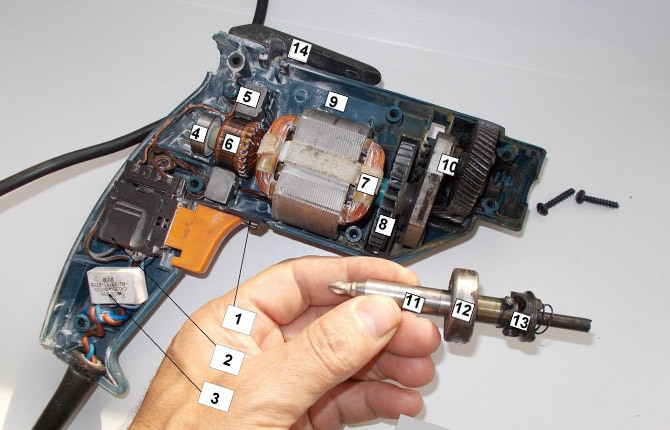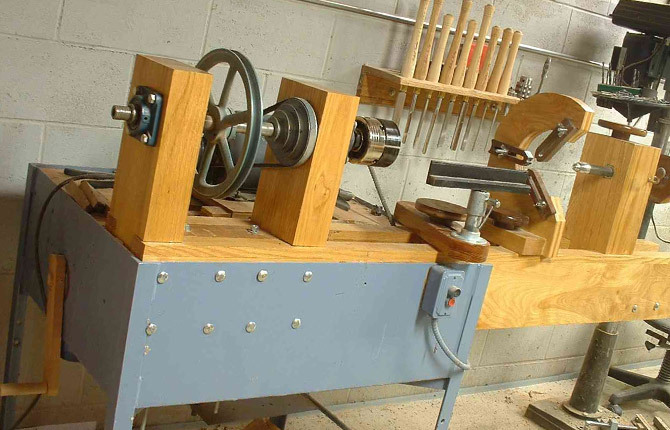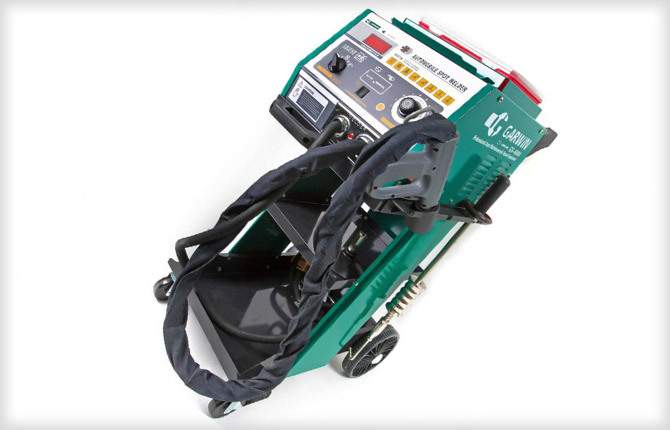Today, wall cladding with plasterboard sheets confidently holds the first place, far ahead of traditional plaster, and even more so plastic, lining, all kinds of slats and panels. Therefore, the problem of choosing a dowel for drywall is encountered quite often. From simply hanging a book shelf to the need to attach heavy furniture to drywall.
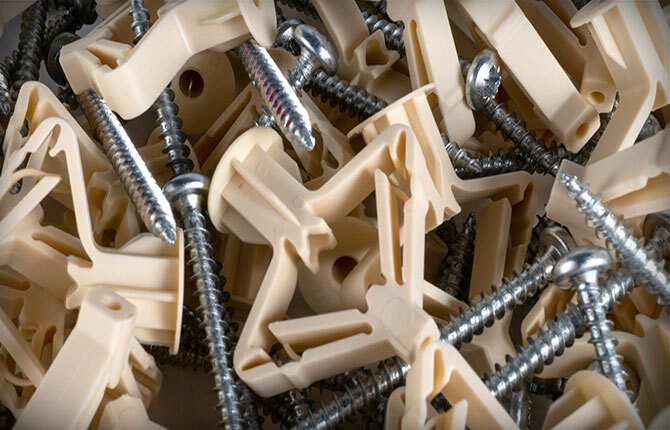
The content of the article:
- Requirements for drywall fasteners
-
Varieties
- Driva
- Butterfly
- Molly
- Hartmut Knauf
- Fisher
-
Universal dowels
- Classic dowel in drywall
- Fast dowels
- Fasteners for heavy objects
- Is it possible to glue dowels into drywall
- Is it possible to use foam block models
- Results
Requirements for drywall fasteners
Of all the options for facing materials, drywall sheets are the most difficult to install fasteners. The main problem is the soft structure of the gypsum core. There is no strong and rigid support for fasteners, as in the case of brick or concrete. Any excessive contact pressure on the gypsum board material immediately results in spalling of the gypsum core.
Therefore, drywall dowels are designed based on the following requirements:
- fastening is carried out through, the sheet is always drilled through so that the back side of the material can also be used;
- the load should be distributed evenly over the surface of the drywall;
- for fastenings under a small load, cutting (threading or notching) into the sheet gypsum is allowed.
The main requirement for dowels is related to the magnitude of the withstand load. For simple fastenings on a single sheet, it should be at least 15 kg for pulling out, and 20 kg for shearing. For complex prefabricated dowels 30 and 45 kg respectively. If you need to make high-strength fasteners for drywall, then the limits should be 60 kg and 80 kg, respectively.
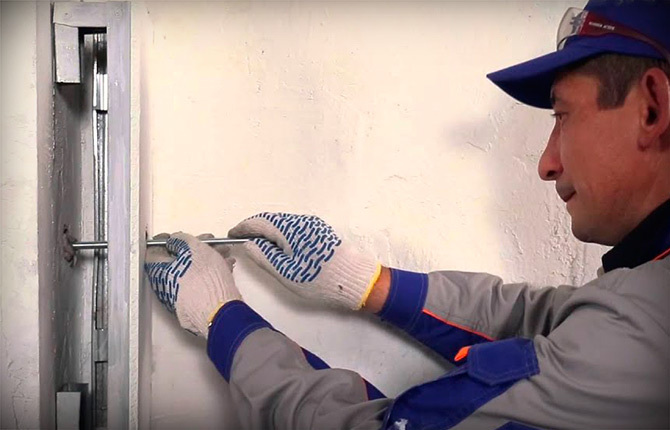
Another requirement is related to the stability of the fastening. Drywall sheets used in wall and ceiling cladding are relatively thin, 10-12 mm, so it is not possible to hammer in long dowels of 40-60 mm.
The fastening design must stably hold the self-tapping screw or screw in a horizontal position under load. That is, a properly installed dowel should securely hold the fasteners in their original position throughout the entire service life.
Varieties
The requirements for installing fasteners on drywall are quite stringent. Therefore, for a reliable "landing" of the dowel-cork in the sheet, it is necessary to use special collapsible structures with additional support on the back, and often the front surface of the drywall. Only for the lightest fasteners, it is allowed to use self-tapping dowels like a self-tapping screw (nagel), but with a different helical surface profile.
The most common types of fixing dowels, designed specifically for installation in soft plaster:
- specialized models for mounting fasteners on thin plates;
- universal plugs-dowels;
- fasteners such as "Auger" or "Driva";
- fasteners with breaking frame walls of the cork - "Butterfly" or "Molly"4;
- Fisher system;
- clamp Hartmut Knauf.
All drywall dowels, except Driv, are disposable. Re-installation is not allowed, even if externally the hull and main structural elements appear intact. Therefore, when facing walls with drywall, it is better to buy dowels with a margin. In addition, some of the fasteners will be used up when mastering the installation method.
Useful:
- Types of dowels for foam block
- Dowel for brick
Driva
Small dowel made of nylon, polypropylene or zinc alloy. For the huge helical spiral on the surface, it is sometimes called auger or drill fasteners.
In fact, this is a plastic plug into which, after screwing into drywall, a hex head screw will be additionally wrapped. Metal screw dowels are typically used to stitch two sheets of drywall into one package. This scheme is used if you want to hang a heavy cabinet or shelf on the wall. A double sheet, respectively, will withstand a double load.
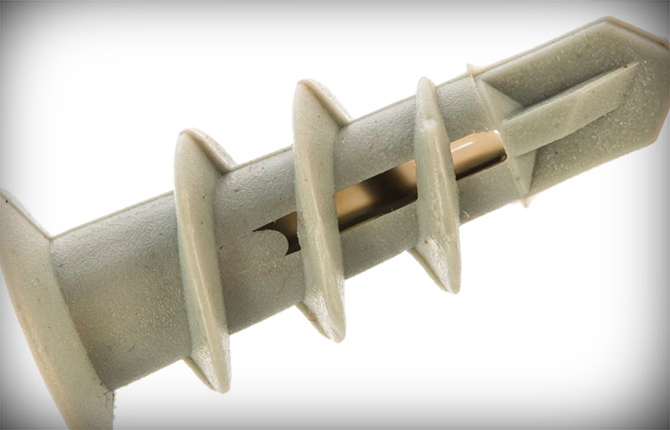
The design feature of Driva is a drill-tip at the end. You can not drill a hole in the drywall, but immediately screw the fasteners into the sheet. The method is convenient, but many craftsmen still prefer to pre-make a 3 mm hole, and then just wrap the fasteners in plaster.
If the sheet is too thin, from 6 mm to 8 mm, then the number of spiral turns that cut into the wall does not exceed 2-3. This is not enough, so Driva is either lubricated with PVA-M glue, or a small piece of drywall sheet is additionally glued on the back of the drywall, a piece of 40x40 mm is enough.
The fastening strength of the Auger is small, for a horizontal load the limit is 20 kg, for a shear load - 35 kg. In a package of two sheets, respectively, 40 kg and 70 kg.
If necessary, Driva can be reused, especially for metal screws. But the number of re-installations is also limited, for plastic - no more than three, for zinc-aluminum - up to 5 times.
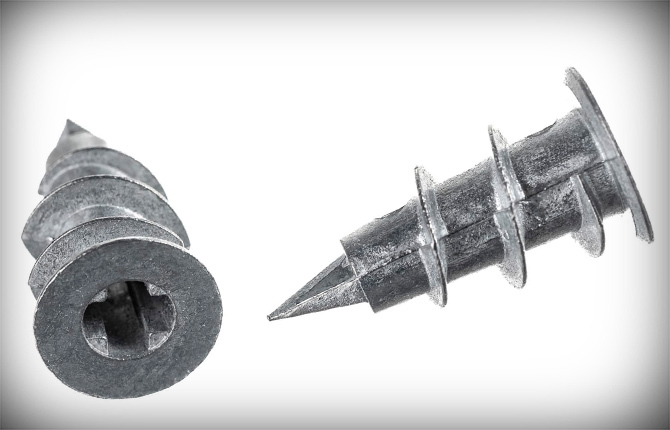
For dowels of the Driva type there is one limitation. If the diameter of the fastener is almost always equal to the thickness of the drywall, this means that when screwing the Auger you need to hold the screwdriver so that the axis of rotation of the cartridge is strictly perpendicular to the plane sheet. A slight distortion causes the sharp edges of the spiral to cut out the soft plaster, and the dowel falls out of the hole.
In addition, you need to pre-adjust the clutch on the cartridge so that the screwdriver tightens Driva into drywall with a force of no more than 3-5 N * m. Then, when screwing the self-tapping screw into the dowel, the Auger itself will fall into place with the required effort.
Butterfly
Specialized dowel for fixing on drywall. Often they try to use it for fasteners for brick or concrete. This is not a very good option. Much better installation results on light blocks - foam concrete and gas block.
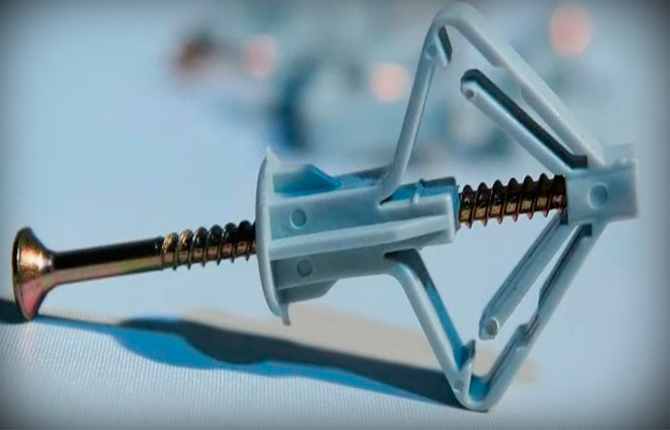
Structurally, the Butterfly is a plastic frame with two bushings at the ends. When installed, the dowel deforms and turns into a cork. The fastening strength on the basis of a butterfly is 40 kg for peel, 35 kg for shear.
To install the Butterfly, you first need to select a point and drill a hole equal to the diameter of the frame.
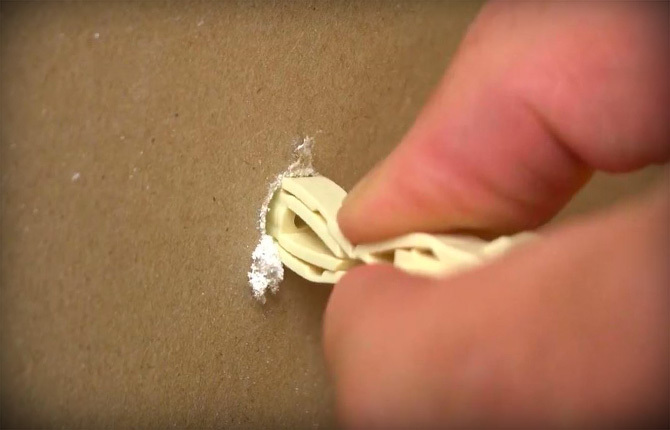
Further, squeezing the frame with your fingers, you need to push it inside the hole until it stops, the annular side should “sit down” on the drywall.
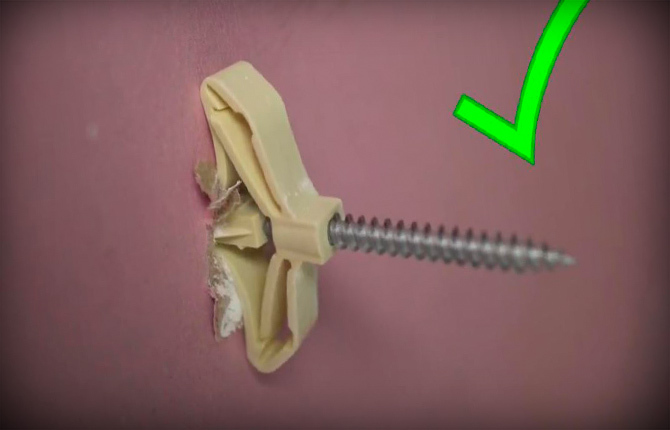
Only then can a self-tapping screw or screw be screwed into the dowel. But you need to ensure that at the moment of tightening the frame on the back is vertical, otherwise the fastening will turn out to be fragile.
There are two additional plastic "antennae" inside the plastic frame. When screwing the self-tapping screw into the dowel, the mustache is unclenched and enters the corner grooves. Thus, the dowel is fixed in a compressed position. Even if you tighten the fasteners with the utmost force, this will not lead to breakage of the plastic frame.
Butterfly is one of the few structures that hold the vibration load.
The deformed plastic frame acts as a spring, so hanging kitchen cabinets can be safely attached to the Butterfly. As a rule, opening and closing the door creates an additional load on the mount. Butterfly handles it best. Whereas the Molly-Auger breaks drywall pretty quickly and falls out of the hole.
Reading: How to choose good dowels for aerated concrete
Molly
The dowel is made of mild annealed zinc coated steel. By design and principle of action, Molly strongly resembles a Butterfly. The central sleeve is thin-walled with four longitudinal cuts.
At the end there is a bushing with a threaded screw. When twisting, it breaks the frame and folds it into a pyramid shape. Molly is one of the best options for attaching items weighing up to 25-30 kg to drywall.
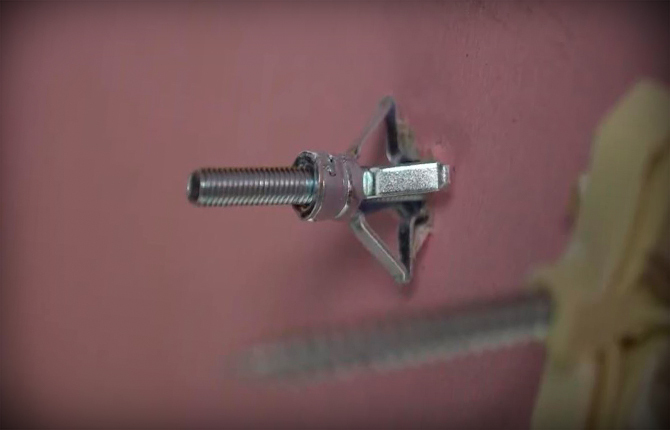
In order to install a Butterfly or Molly-type dowel, it is necessary that there is a free space of 40-50 mm on the back side. Otherwise, the frame simply cannot be inserted into the hole to the end. Therefore, when walls made of brick or concrete are sheathed with drywall and Molly is planned to be installed, then you have to additionally choose wall material using a perforator.
Molly has another flaw. The metal of the sleeve, even of small thickness, is very hard to deform at the initial stage. When tightening with a screwdriver, you have to turn the screw with quite a lot of effort. The dowel manufacturer installed an additional toothed washer on the side to prevent the dowel from turning in the drywall when the screw is tightened.
But all the same, it is quite difficult to rip off the petals of the sleeve, to make them begin to deform, often the first turn of the screw in the dowel has to be done while holding the screwdriver with both hands.
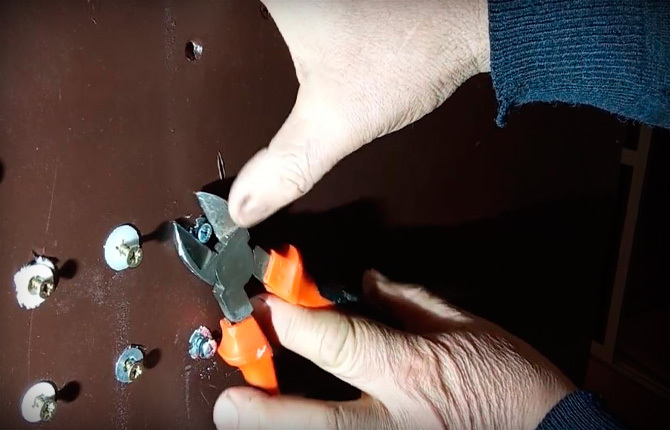
If there is no screwdriver, then the first turn of the screw can be done in the following way:
- after installing the sleeve in drywall, you need to turn the screw to the end, and then turn it back so that there is a gap of 1.5-2 mm between the toothed washer and the head;
- we take side cutters (for biting off the wire) with cutting edges beveled with a wedge;
- we open the side cutters, bring them under the head and, using the tool as a lever, squeeze the screw “toward ourselves” by 1-2 mm.
You can repeat the procedure, after which the screw on Molly is tightened with a conventional screwdriver with one hand with medium force.
Hartmut Knauf
The original development of the Knauf company - the world leader in the production of sheet gypsum board, putties and various types of auxiliary fasteners. The company has developed a specialized dowel specifically for attaching heavy objects to drywall sheets. At the same time, the main emphasis was placed on the simple and quick installation of the dowel. The Hartmut Knauf system is considered the most popular among facing masters.
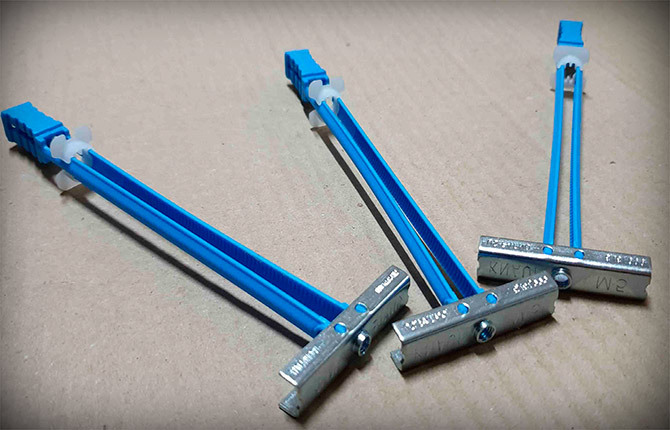
The dowel scheme differs significantly from all existing types of fasteners. Such a device costs 10 times more than a regular Butterfly, but this does not affect the popularity of Hartmut Knauf.
The mount consists of four parts:
- profiled steel U-shaped strip with a central threaded hole and two pairs of holes on the side shelves;
- two flat polypropylene bundles;
- plastic sleeve;
- screw.
Plastic harnesses are fixed on a U-shaped bar so that all parts can simultaneously turn into one line. Hartmut Knauf, subject to the installation technology on drywall, is able to withstand a load of up to 100 kg. Moreover, the installation process itself does not require additional preparation and can be performed simultaneously with the laying of drywall sheets on the wall.
Initially, you need to drill a hole in drywall, the diameter of the drill can be read from the markings on the profiled bar. Next, the dowel is folded into one line and pushed into the hole with a steel bar forward.
The next step is to, while holding the transparent sleeve in the hole, with the other hand, pull both harnesses towards you at the same time. The U-shaped bar will pull up and stand on the back of the sheet, right in front of the hole in the drywall.
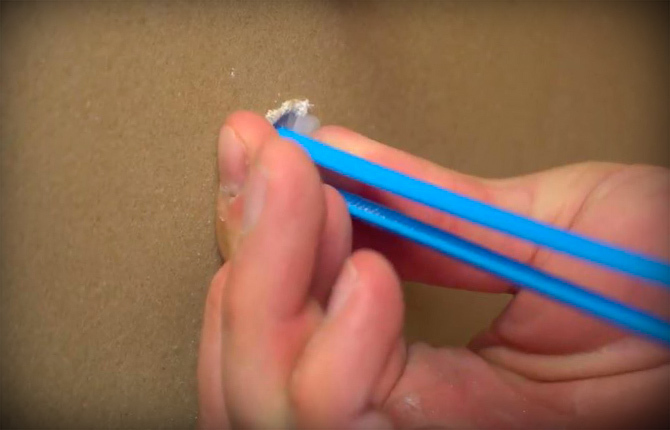
It remains to bend the harnesses, insert the screw and, holding the dowel by the sleeve, tighten the fasteners with a screwdriver. After installing the mount in drywall, the "mustache" is cut off.
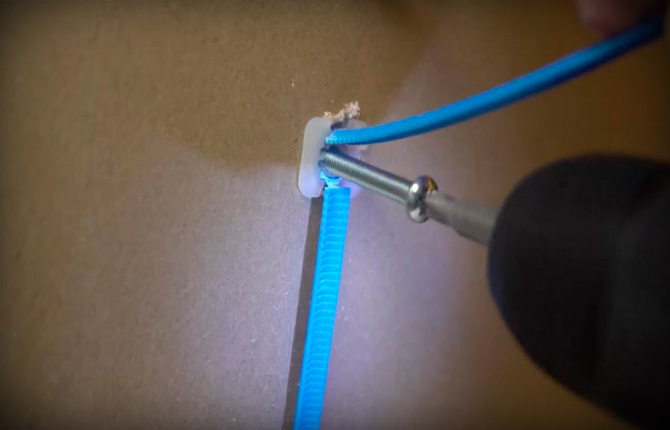
If necessary, you can shorten the length of the screw, but you need to cut it very carefully so as not to damage the thread on the rod, otherwise you will not be able to tighten the fastener.
Builders often call Hartmut fasteners for the lazy. Its installation requires 2-3 times less effort and time than any other fastener of similar strength.
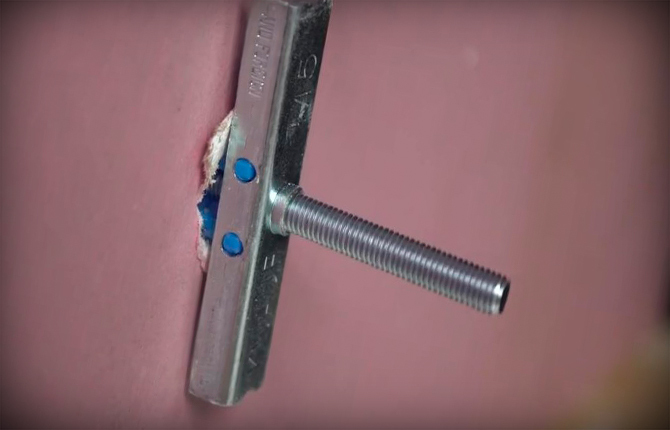
Sometimes the harnesses do not break off, but are used for temporary fastening (or permanent) wiring, pipes, guides, and various fittings. The length of the bundle after installation in drywall is 120-140 mm. In order to fix the wiring on drywall, you just need to wrap the cable with bundles and fix them with a stapler.
Fisher
This is a whole line of models of dowels of a well-known manufacturing company. Dowel plugs are easily recognizable by the characteristic color of the plastic plug.
One-color, gray - these are universal dowels for fixing in material with voids. When tightening the self-tapping screw from the back side, a knot is formed due to the crushing of the plastic. At the same time, the side has 6-8 pieces of additional ribs that cut into the drywall material and prevent the cork from turning when the screw is screwed.
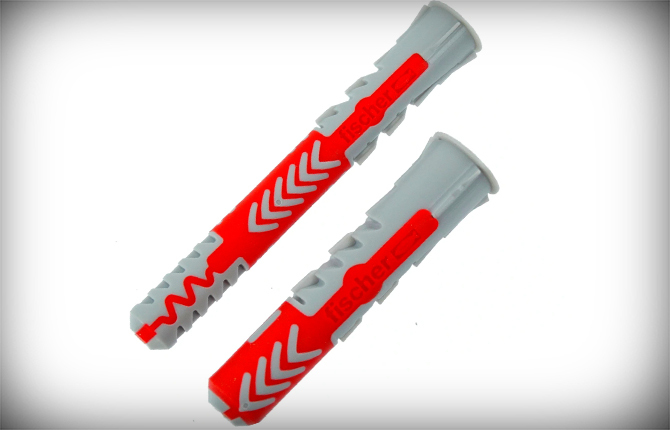
The strength of such fasteners is relatively low - up to 30 kg per cut. Therefore, for drywall, specialized dowels are more often used. They have a characteristic red-gray color. The case looks two-tone due to the fact that it is made of two different polymers. Gray is a rigid nylon base, red is a polyethylene soft insert.
Advice! When choosing a dowel for drywall, you need to pay attention to the labeling and description of the fasteners. There are quite a few models on the market, including gray-red colors, and not all of them are suitable for mounting on drywall.
Unlike the universal versions of the Fishers, special dowels do not twist into a knot when installing a self-tapping screw, but take the form of a cruciform pyramid. In appearance, it is very similar to the deformed frame of the Butterfly dowel. The cruciform pyramid has a much larger area of support than the knot, so the fastening strength is quite high, 35 kg for a horizontal load and 40 kg for a shear one.
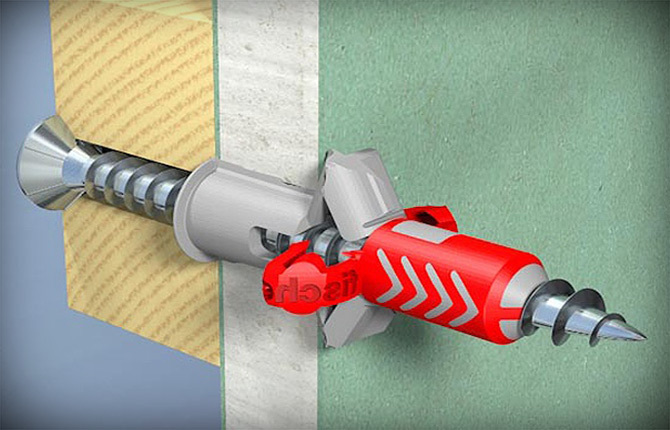
Fisher's only drawback is that branded dowels are massively counterfeited. A real Fisher costs much more than a Butterfly, and if you look closely, you can see how well the cork is made.
Fakes, as a rule, can be distinguished by the low quality of polymer inserts, multiple defects and casting residues on the dowel body. Otherwise, Fisher deserves to lead the rating of drywall fasteners.
Universal dowels
Fasteners of a special design, designed specifically for drywall sheets, are relatively inexpensive. One dowel with a self-tapping screw costs between 20 rubles and 300 rubles (Hartmut Knauf), but in practice, homeowners often save money.
For some reason, it is considered normal to simply wrap the joiner's self-tapping screw directly into the drywall, without any dowel. Not the best solution, especially when you consider that the strength of such an attachment is no more than 0.5 kg on drywall with a thickness of 6 mm and 0.8-1.2 kg for a sheet of 8-10 mm.
Classic dowel in drywall
But the problem is not even in the limit load. If necessary, the number of screws can be increased. But in order to hang some object, the screw head must be unscrewed by 3-4 mm, otherwise the loop or bracket simply will not fit on the fastener. In this position, the mount loosens up quite quickly, so it’s better to immediately install dowels, even the simplest ones.
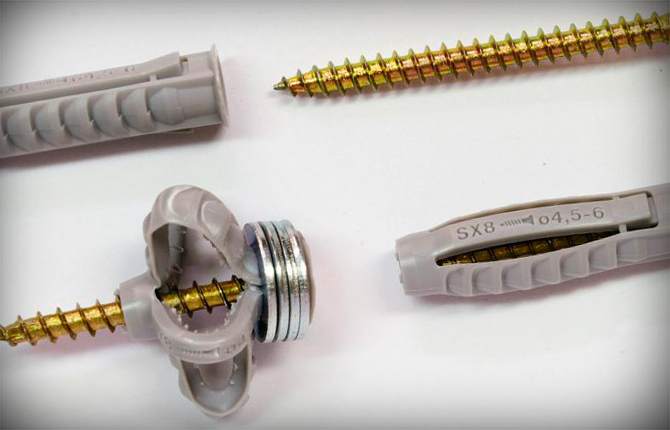
For example, you can drill a hole and hammer in a regular 8x30 mm nylon dowel. Such a mount already withstands a load of up to 15 kg for shearing and 10 kg for tearing off.
Fast dowels
According to the device, they differ from universal models in the absence of annular grooves and longitudinal cuts. But on the other hand, three longitudinal edges are added along the dowel body. When installed, they cut into drywall and hold fasteners well. The maximum load on the cut is up to 20 kg.
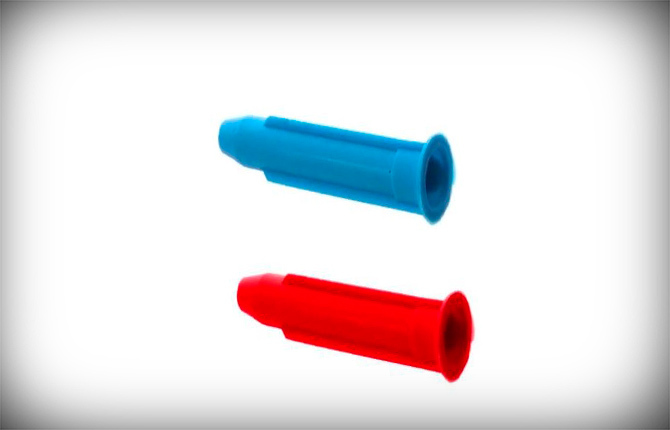
When the self-tapping screw is screwed in, a part of the dowel on the back side is twisted, the edges turn into spirals and block the exit of the cork from the hole.
Fasteners for heavy objects
If for light objects the solution is obvious, then for a radiator or a massive shelf you have to look for a special version of the dowel. For example, dowels can be used to attach to thin cladding (plate), including chipboard, OSB, and drywall.
Important! Such fasteners can be used on drywall with a thickness of 12 mm.
The dowel is sold complete with a hook and a polypropylene support washer. Several spiral cuts are made on the body, which should facilitate the twisting of the cork in the process of tightening the hook. Typically, dowel manufacturing companies paint them in certain colors.
Gray plugs are the weakest. They withstand a maximum of 20 kg and 35 kg for pulling and shearing respectively.
Blue plugs can be placed under heating radiators. They withstand horizontal force up to 50 kg and shear up to 60 kg.
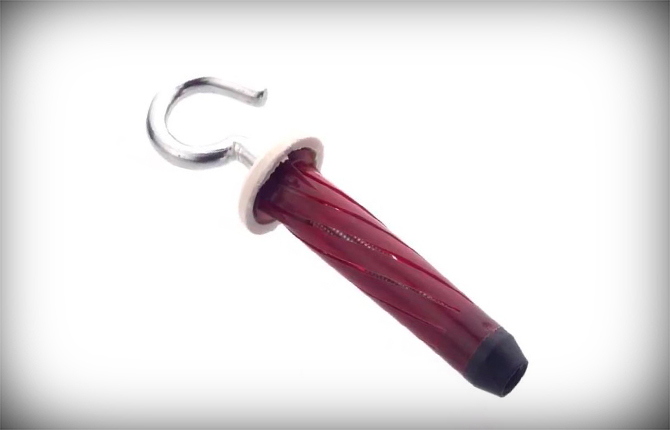
Reds can withstand up to 70 kg, but they only need to be placed on double drywall.
All three types of dowels are mounted in a 10 mm hole. The cork is inserted inside together with the screwed hook. Otherwise, you can’t insert it, too soft and flexible body material bends and deforms.
When twisting the hook to its full length, a blocking knot is formed on the back of the drywall. But, since on the surface of the hook there is not a spiral winding, but a full-fledged M6 thread, if necessary, you can unscrew the fasteners from the drywall sheet.
According to the manufacturing company, after a few months the plastic hardens, and the assembly acquires additional rigidity. Therefore, if the hook in the dowel sits too “softly”, then this is not a reason to panic, after a few months the rigidity of the fasteners will increase significantly.
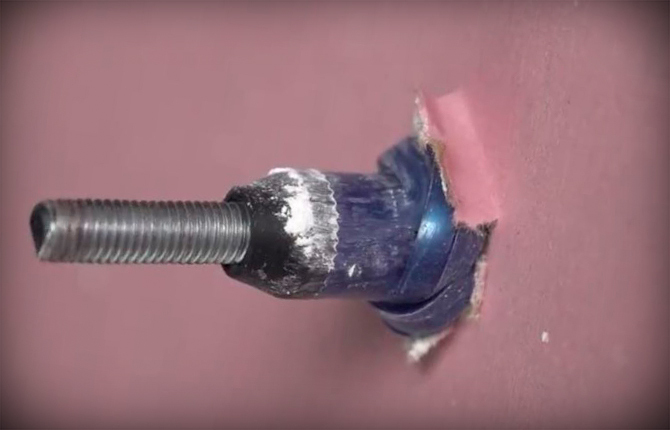
In many cases, craftsmen apply a small amount of adhesive to the leading edge before installing the dowel. After twisting, the glue dries and blocks the thread. That is, the fasteners turn out to be non-separable, it's the same as hammering a nail.
Is it possible to glue dowels into drywall
It is clear that the cork under the self-tapping screw can be glued into the drywall sheet, as is often done to install fasteners on gypsum plaster. Homemade dowels are used for packages of two sheets or on drywall with a thickness of at least 12 mm.
Wood blanks are used as the material. Acacia or oak is best suited. It is necessary to cut a cork of a cylindrical shape 30-45 mm long. The diameter of the homemade dowel is selected depending on the load on the drywall.
For example, for a shelf weighing 5-10 kg, two corks with a diameter of 25 mm will suffice. On the back side of the dowel, two axial cuts are made to a depth of 15 mm. Two holes are made in the center. The first is carried out with a through, 3 mm drill, the second with a diameter of 4 mm to a depth of 20 mm from the front side.
A hole in drywall is cut with an annular drill exactly according to the diameter of the cork. Before installing the dowel, freshly diluted alabaster or gypsum is applied to the surface of the cork and the edge of the hole. After that, the fasteners are recessed into the hole, only a small edge of 3-5 mm remains outside, for which it can be held with pliers or a key.
The self-tapping screw is twisted, not reaching the tree 3-4 mm. The protruding remains of the cork are cut off with a hacksaw blade, and after 10-15 minutes it is necessary to tighten the self-tapping screw to the desired position.
The fastening strength of a homemade cork is 40-45 kg.
Is it possible to use foam block models
Of all the options for dowels for foam concrete, two types can be used as fasteners:
- sleeve split plugs;
- polypropylene screws.
Both options are installed in drywall in the same way as in foam concrete. Holes for fasteners are drilled with a diameter slightly smaller than the size in the smallest section of the sleeve or screw.
Before installing in the hole, the cork must be dipped in diluted alabaster. This will increase the adhesion of the steel sleeve to the walls of the hole. When tightening the screw dowel, it is better to use glue, PVA-M or any other water-based one is suitable.
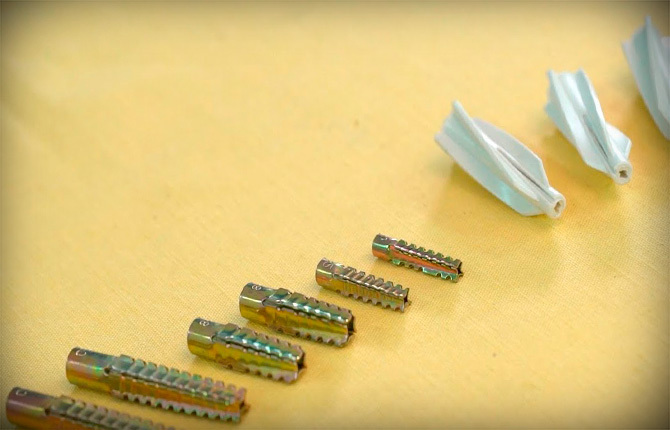
In both cases, the fastening strength is obtained approximately at the level of Driva. If it is required to increase the bearing capacity of the fastener, then a plastic washer is glued under the cork. It increases the bonding area of the dowel and reinforces the edges around the hole.
Results
The choice of a particular model of drywall dowel directly depends on the required fastening strength. If the load on the fasteners is small, then universal models of dowels can be used. For heavy and bulky items, it is better to choose reinforced plugs or fasteners for thin cladding plates.
Tell us about your experience in choosing fasteners. Which option do you think is the most successful? Leave comments, share the article on social networks and bookmark it.
